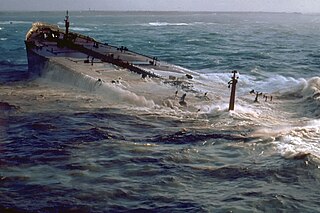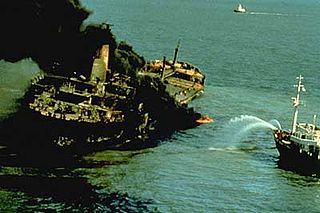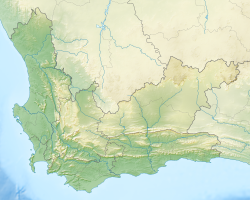
Amoco Cadiz was a VLCC owned by Amoco Transport Corp and transporting crude oil for Shell Oil. Operating under the Liberian flag of convenience, she ran aground on 16 March 1978 on Portsall Rocks, 2 km (1.2 mi) from the coast of Brittany, France. Ultimately she split in three and sank, resulting in the largest oil spill of its kind in history to that date.

A tanker is a ship designed to transport or store liquids or gases in bulk. Major types of tankship include the oil tanker, the chemical tanker, and gas carrier. Tankers also carry commodities such as vegetable oils, molasses and wine. In the United States Navy and Military Sealift Command, a tanker used to refuel other ships is called an oiler but many other navies use the terms tanker and replenishment tanker. Tankers were first developed in the late 19th century as iron and steel hulls and pumping systems were developed. As of 2005, there were just over 4,000 tankers and supertankers 10,000 LT DWT or greater operating worldwide.
SS Atlantic Empress was a Greek oil tanker that in 1979 collided with the oil tanker Aegean Captain in the Caribbean, and eventually sank, having created the fifth largest oil spill on record and the largest ship-based spill having spilled 287,000 metric tonnes of crude oil into the Caribbean Sea. It was built at the Odense Staalskibsværft shipyard in Odense, Denmark, and launched on 16 February 1974.
The MV Sea Empress was a single-hull Suezmax oil tanker that ran aground at the entrance to the Milford Haven harbour on the southwest coast of Wales in February 1996. The ensuing oil spill, Britain's third largest oil spillage and the 12th largest in the world at the time, devastated a considerable area of local coastline and killed many birds, and continued to affect the Pembrokeshire coast for years afterwards.

MT Haven, formerly Amoco Milford Haven, was a VLCC, leased to Troodos Shipping. In 1991, while loaded with 144,000 tonnes of crude oil, the ship exploded, caught fire and sank off the coast of Genoa, Italy, killing six Cypriot crew and flooding the Mediterranean with up to 50,000 tonnes of crude oil. It broke in two and sank after burning for three days.
Jakob Maersk was an oil tanker registered in Denmark that struck a sand bank on January 29, 1975 while entering the port of Leixões, Portugal, causing a major oil spill.

The MT Hebei Spirit oil spill was a major oil spill in South Korea that began on the morning of 7 December 2007 local time, with ongoing environmental and economic effects. Government officials called it South Korea's worst oil spill ever, surpassing a spill that took place in 1995. This oil spill was about one-third of the size of the Exxon Valdez oil spill.
The West Cork oil spill was an oil spill off the southern coast of Ireland. The spill was first identified by the European Maritime Safety Agency's CleanSeaNet satellite monitoring system on 14 February 2009. An Irish Air Corps marine patrol aircraft confirmed the slick's presence near the Russian aircraft carrier Admiral Kuznetsov which was undergoing refuelling around the same time. The British Coastguard and Irish Department of Transport agreed that around 300 tonnes of oil were spilled. The Russian Navy accepted responsibility for the incident but disputed the quantity, claiming around 20-30 tonnes had been spilt either whilst washing the decks or pumping out the bilges of the carrier, the Russian Navy made no notification to any authority at the time of the spill. The oil spill drifted eastwards and there were fears that the spill would wash up on the coast of south eastern Ireland or Wales but it broke up before this.
Katina P was a Greek oil tanker carrying 72,000 tonnes of oil which sank off the Mozambique coast on 26 April 1992.

The VLCC Metula was in a supertanker that was involved in an oil spill in Tierra del Fuego, Chile in 1974. The ship was a Very Large Crude Carrier (VLCC), with a length of 1,067 feet, draft of 62 feet and a deadweight ton capacity of 206,000. It was the first VLCC supertanker to be involved in a major oil spill.

The M/T Burmah Agate was an oil tanker that was involved in a nautical collision and subsequent oil spill near Galveston, Texas in November 1979. 31 crewmen were killed in the collision, and the oil spill damaged the local environment.
The Venpet–Venoil collision was a maritime accident involving sister supertankers; the Liberian-registered Venoil and Venpet, in dense fog off the coast of South Africa on 16 December 1977. The tankers were travelling in opposite directions; the Venoil fully laden with over 250,000 tonnes of crude oil bound for Halifax, Canada, and the Venpet, travelling in ballast, headed for Kharg Island, Iran. The Venoil ploughed into the Venpet, eventually leading to the spilling of approximately 26,600–30,500 tonnes of crude oil. The tankers were sister ships owned and operated by Bethlehem Steel Corporation. Both ships were manned by Taiwanese crews.
The Oswego-Guardian–Texanita collision was a maritime accident between two supertankers near Stilbaai, South Africa on 21 August 1972. The Texanita exploded and sank with the loss of 47 men, while a further life was lost on the Oswego Guardian. The accident was a catalyst for change to marine traffic separation procedures as well as oil tanker inerting.
This is a list of notable events relating to the environment in 1971. They relate to environmental law, conservation, environmentalism and environmental issues.
The MV Treasure oil spill occurred on 23 June 2000, when the ship sank six miles off the coast of South Africa while transporting iron ore from China to Brazil. The ship was carrying an estimated 1,300 tons of fuel oil, some of which spilled into the ocean, threatening the African penguin populations living on nearby islands. Cleanup efforts began promptly after the incident with particular attention being paid to salvaging the penguin communities.
The MT Castillo de Bellver oil spill began on 6 August 1983, when the Spanish tanker caught on fire off Saldanha Bay, approximately 70 miles northwest of Cape Town, South Africa. It was carrying 250,000 tonnes of light crude oil, and was traveling through an environmentally sensitive area known for its seabird rookeries and important commercial fishing grounds. The burning vessel was abandoned and broke apart after drifting offshore. Three crew were lost. The stern capsized and sunk and the bow was sunk using explosives. A total of 145,000-170,000 tonnes of oil entered the sea. Onshore impacts were considered negligible as the slick traveled seaward. The only visible impact was the oiling of 1,500 gannets that were on a nearby island.
MVABT Summer was an oil tanker which was built at the South Korean shipbuilding yard of Ulsan and launched in 1974. The vessel was 344 meters in length and almost 54 meters in breadth. While under a Liberian flag, fully laden with Iranian crude and en route to Rotterdam, she sank 700 nautical miles off the Angolan coast. An unexplained explosion occurred on May 28, 1991, and the ship and its cargo began to burn. Five of the crew of thirty-two were killed in the incident, four of whom were initially reported as missing. The following day, a slick 32 kilometres (20 mi) long and 7 kilometres (4.3 mi) wide began to form. The ship continued to burn for three days before sinking on June 1. The vessel's 260,000 tonne cargo of oil was lost, leaving a visible slick on the ocean surface of approximately eighty square miles. Attempts to locate the wreck following the incident proved unsuccessful.
The Sanchioil tanker collision occurred on 6 January 2018 when the Panamanian-flagged, Iranian-owned tanker Sanchi, with a full natural-gas condensate cargo of 136,000 tonnes, sailing from Iran to South Korea, collided with the Hong Kong-flagged cargo ship CF Crystal 160 nautical miles (300 km) off Shanghai, China. Sanchi caught fire shortly after the collision; after burning and drifting for over a week, it sank on 14 January.
In late December 1989 and early January 1990, an estimated 70,000 tons of crude oil spilled from the Iranian oil tanker Khark 5 after she suffered a hull breach on 19 December in the mid Atlantic Ocean off of Morocco.






